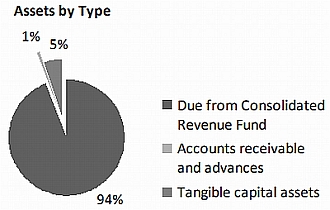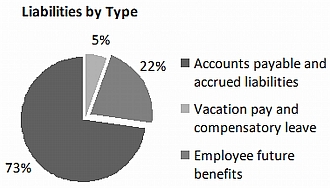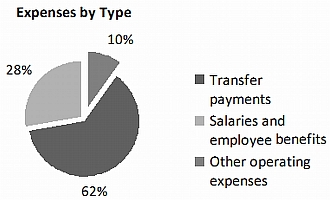Common menu bar links
Breadcrumb Trail
ARCHIVED - Status of Women Canada - Report
 This page has been archived.
This page has been archived.
Archived Content
Information identified as archived on the Web is for reference, research or recordkeeping purposes. It has not been altered or updated after the date of archiving. Web pages that are archived on the Web are not subject to the Government of Canada Web Standards. As per the Communications Policy of the Government of Canada, you can request alternate formats on the "Contact Us" page.
Section III – Supplementary Information
3.1 Financial Highlights
The financial highlights presented within this Departmental Performance Report are intended to serve as an overview of the organization’s financial position and operations.
| ($ thousands) | |||
|---|---|---|---|
| % Change | 2009–10 | 2010–11 | |
| ASSETS | |||
| Financial assets | 17% | 3,539 | 4,126 |
| Non-financial assets | (17%) | 273 | 226 |
| Total Assets | 14% | 3,812 | 4,352 |
| LIABILITIES | |||
| Total Liabilities | 16% | 5,353 | 6,229 |
| EQUITY | |||
| Total Equity | (22%) | (1,541) | (1,877) |
| TOTAL | 14% | 3,812 | 4,352 |
| ($ thousands) | ||||
|---|---|---|---|---|
| % Change |
2009–10 | 2010–11 | Forecast 2010–119 |
|
| EXPENSES | ||||
| Total Expenses | (5%) | 32,895 | 31,400 | 32,266 |
| REVENUES | ||||
| Total Revenues | — | — | 0 | 0 |
| NET COST OF OPERATIONS | (5%) | 32,895 | 31,400 | 32,266 |
Total assets were approximately $4.4 million at the end of 2010–2011, a 14% increase over the previous year’s total. Of this amount, 94% or approximately $4.1 million is “Due from the Consolidated Revenue Fund”; 5% or approximately $0.2 million is “Tangible Capital Assets”; and 1% or $0.02 million is “Receivables and advances.”
In 2009–2010, SWC conducted a review of all its capital assets and associated amortization. Changes and corrections led to the continued decrease in SWC’s non-financial assets.

Total liabilities were approximately $6.2 million at the end of 2010–2011, a 16% increase from the previous year’s total. Accounts payable and accrued liabilities are the largest component of liabilities. Together they represent 73% of total liabilities.
The 16% increase is mostly explained by the addition of new accounts payable for transfer payments to different organizations.

Total expenses for SWC were $31.4 million in 2010–2011, a 5% decrease from the previous year’s total. This decrease is mostly explained by SWC’s participation in government-wide reduction exercises, respecting the limits on travel, hospitality and conference spending and the sunsetting of a five-year transfer payment program in 2009–2010.

Comparison of Forecast Results (As Per the Organization’s 2010–2011 Future-oriented Financial Statements) and Actual Results: The organization’s final net cost for operations in 2010–2011 was approximately $866 thousand less than anticipated in the future-oriented financial statements included in SWC’s 2010–2011 Report on Plans and Priorities ($31.4 million versus $32.3 million). This represents a 3% variance and is explained as follows:
The future-oriented financial statements were prepared based on Parliamentary appropriations received as of the 2010–2011 Main Estimates. They did not consider expenditures as a result of resources received for the remainder of the year and/or a variation in voted resources for such items as:
- “carry-forward” amount from 2009–2010;
- funding received through Supplementary Estimates B; and
- maternity, severance payments and employee benefits plan.
Other explanations for the variance relate to unplanned lapses in both contribution funding and operating expenditures.
3.2 Financial Statements
For financial statements, please visit:
http://www.swc-cfc.gc.ca/account-resp/pr/fin/index-eng.html
3.3 List of Supplementary Information Tables
All electronic supplementary information tables in this Report can be found on the Treasury Board of Canada Secretariat’s website at:
http://www.tbs-sct.gc.ca/dpr-rmr/2010-2011/index-eng.asp
- User Fees Reporting
- Details on Transfer Payment Programs (TPPs)
- Response to Parliamentary Committees and External Audits
- Internal Audits and Evaluations
Section IV – Other Items of Interest
In 2010–2011, SWC carried out a number of communications activities to advance equality for women, particularly in the areas of: women’s economic security and prosperity, violence against women and girls, and women’s leadership and decision-making roles.
Commemorative Events: SWC promoted awareness of milestones in the history of women in Canada. The commemorative dates are: International Women’s Day (March 8), Women’s History Month (October), Persons Day (October 18) and the National Day of Remembrance and Action on Violence Against
Women (December 6). By highlighting these commemorative events, the agency helped educate Canadians about the challenges still facing women and girls in our society.
Governor General’s Awards in Commemoration of the Persons Case: SWC organized and facilitated the annual awards ceremony, which honours individual Canadians for their contributions to the goal of equality for women in Canada. The awards commemorate the 1929 legal victory that changed the course of
history for women in Canada. These awards bring attention to the important work being undertaken by the diversity of Canadians, in Canada.
Funding Announcements and Project Launches: SWC supported the Minister for Status of Women and other members of Parliament to reach out to Canadians and communicate key messages during public announcements and launches of projects that received SWC funding. Using a
variety of products and services, the agency communicated to Canadians its activities in its three priority areas: promoting women’s economic security and prosperity; ending violence against women and girls; and encouraging women to participate in leadership and decision-making roles.
Community Engagement: SWC supported the Minister for Status of Women and other officials in conceiving and carrying out roundtable meetings with groups and individuals. These events enabled the Minister to ensure that the government is responsive to the issues facing Canadian women and girls.
Organizational Contact Information
For financial information, contact:
Johanne Tremblay
A/Director, Corporate Services
Telephone: 613-995-3817
Fax: 613-947-6113
E-mail: Johanne.Tremblay@swc-cfc.gc.ca
For other information, contact:
Ainalem Tebeje
Manager, Corporate Planning and Reporting
Telephone: 613-995-1811
Fax: 613-947-0530
E-mail: Ainalem.Tebeje@swc-cfc.gc.ca
Footnotes to the Report
1 GBA is the process of examining a policy/program or initiative for its impact on women and men in all their diversity.
2 The labour market participation rate for women rose from 57% in 1996 to 62.6% in 2009.
3 Women represented 47.3% of the total workforce in 2009, up from 45.7% in 1999.
4 The employment rate for women increased by 17.4 percentage points, rising from 41.9% in 1976 to 59.3% in 2008.
5 Roughly one million women are self-employed. This figure is increasing, from 8.6% in 1976 to 11.9% in 2009.
6 Commencing in the 2009–1010 Estimates cycle, the resources for Program Activity: Internal Services are displayed separately from other program activities; they are no longer distributed among the remaining program activities, as was the case in previous Main Estimates. This has affected the comparability of spending and FTE information by program activity between fiscal years.
7 Non-audited departments included: Agriculture and Agri-Food Canada, Canada Economic Development for Quebec Regions, CanNOR, Canadian Museum for Human Rights, Industry Canada, Public Safety Canada, Public Prosecution Service of Canada, Public Works and Government Services Canada, Canadian Human Rights Commission, Natural Resources Canada, Rural and Co-operatives Secretariat, Public Health Agency Canada, Sport Canada, Telefilm Canada, Department of Fisheries and Oceans, Passport Canada, Department of Foreign Affairs and International Trade and the National Research Council.
8 Intersectionality seeks to examine gender inequality by considering how multiple and simultaneous forms of discrimination interact.
9 As per the organization’s 2010–2011 future-oriented financial statements.
